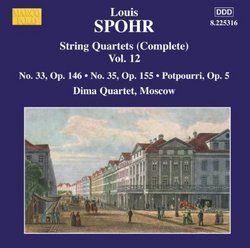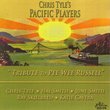| All Artists: Ludwig Spohr, Dima Quartet Title: Spohr: String Quartets Vol.12, Nos.33 & 35 Members Wishing: 0 Total Copies: 0 Label: Marco Polo Release Date: 10/30/2007 Genre: Classical Styles: Chamber Music, Historical Periods, Classical (c.1770-1830) Number of Discs: 1 SwapaCD Credits: 1 UPC: 636943531624 |
Search - Ludwig Spohr, Dima Quartet :: Spohr: String Quartets Vol.12, Nos.33 & 35
 | Ludwig Spohr, Dima Quartet Spohr: String Quartets Vol.12, Nos.33 & 35 Genre: Classical
|
Larger Image |
CD DetailsSimilar CDs |
CD ReviewsSuperb Music and Recording Daniel W. Sneed | houson, tx USA | 12/03/2007 (5 out of 5 stars) "Glorious quartets beautifully performed and recorded. Let's hope the 36th quartet is also to be recorded and released in the near future." The Spohr Quartet Series Finally Adds Another Volume J Scott Morrison | Middlebury VT, USA | 11/19/2007 (4 out of 5 stars) "It's been two years since the last issue in Marco Polo's series comprising the complete string quartets of Louis Spohr (1784-1859) and, like the Energizer bunny, it has kept going and going since 1993. This may very well be the last of the series, although I don't recall whether the last quartet, No. 36, has been recorded yet. But this issue contains two of Spohr's last quartets, Nos. 33 and 35. And it features a new ensemble, the Dima Quartet, Moscow, as many of the other issues have. This quartet, new to me, includes the noted cellist and conductor, Dmitry Yablonsky. And they are sweet-toned and generally quite genial in their approach, which is fitting for the usually not very dramatic music of Spohr. Spohr, although he came after Beethoven and Schubert, was in many ways a conservative, paying allegiance musically to Mozart and Haydn. His music does incorporate some of the harmonic and formal notions of Schubert and Beethoven, plus some of his own, but overall his music is quite easy to follow and is withal quite pleasant. As Spohr was himself a violin virtuoso many of his quartets almost sound like violin concertos with the other three strings playing an accompaniment. But by the time he got to the later quartets there is less of that and more of the contrapuntal intertwining of the four instruments, plus soloist passages for second violin, viola and cello. Quartet No. 33 in G major, Op. 146, begins with a suave first movement that features, for Spohr, a fair amount of chromatic harmony -- it was written, after all, in 1851, a time when chromaticism had marched onto the scene -- ending in two diffident pizzicato chords. The adagio second movement begins with several measures of pizzicato chords before developing into a pensive aria with a bright middle section. The scherzo is affable rather than bumptious and as played here by the Dima Quartet is more 'allegretto' than its marked 'presto'. The finale, beginning in G minor, is altogether more dramatic, particularly in its opening bars. In sonata allegro form, this is the longest of the quartet's movements and clearly its emotional center. The extensive development section, much of it alternating in G major and minor, leads to what sounds to be a conventional recapitulation that finally decides to end in a spirit of resignation. Quartet No. 35 in E Flat Major, Op. 155, was written just two years before Spohr's death. By then Wagner had arrived on the scene -- he was even then writing the groundbreaking 'Tristan und Isolde' -- and of all the quartets I've heard this one ventures furthest from Spohr early quatuors-brillants. For me it is one of the most satisfying. And yet it is reported that Spohr himself put a ban on its performance, even after extensive revisions. This may be due more to his having entered a depression after having broken his arm and having to give up playing the violin for the rest of his life. The quartet is filled with a gentle sadness, even pessimism. It is fairly short, only 21 minutes, and features classical balance, and indeed Spohr wrote of it that he had wanted to return to the classical models of Haydn and Mozart. The first movement, nominally in E flat major, spends much of its time singing a lament in E minor. The second movement is a gentle Romanze. The third movement, marked Menuetto, is a slow triple-meter dance in G major. The finale, which Spohr revised considerably from its original form, is highly contrapuntal and at times the harmonic sequences become just slightly buffoonish in a Haydnesque vein, with youthful high spirits. A most satisfying finish to a marvelous quartet. The CD finishes with one of Spohr's 'quatuor brillant' efforts, the Potpourri No 1 in G Major on Themes from Gaveaux's 'Le petit matelot', Op. 5. This early work, written when Spohr was only twenty and beginning to be known as a violin virtuoso, is a brilliant showcase for violin and string trio accompaniment. This is definitely Tafelmusik and doesn't bear close analysis, but for what it is -- a string of tunes varied brilliantly and accompanied simply -- it is pleasant enough. Sergey Girshenko, the first violinist of the Dima Quartet, does a bang up job with the solo part. Scott Morrison" Marco Polo reaches anther notch in the Complete Spohr Quarte Jay Silman | New York City, New York | 10/13/2008 (5 out of 5 stars) "Volume 12 has just hit the market for sale. Grab it while you can in the quest to obtain the complete string quartets by Ludwig Spohr."
|

 Track Listings (9) - Disc #1
Track Listings (9) - Disc #1

